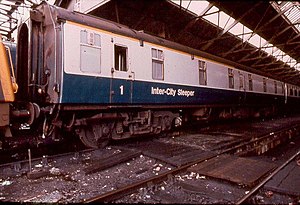Taunton sleeping car fire
| Taunton sleeping car fire | |
|---|---|
 A British Railways Mark 1 sleeping car, similar to the one involved in the accident | |
| Details | |
| Date | 6 July 1978 02:40 |
| Location | Taunton, Somerset |
| Country | England |
| Line | Great Western Main Line |
| Cause | Obstructed electric heater |
| Statistics | |
| Trains | 1 |
| Passengers | ~8 coaches |
| Deaths | 12 |
| Injured | 15 |
| List of UK rail accidents by year | |
In the early hours of 6 July 1978, a fire broke out in a sleeping car train near Taunton, Somerset, England, causing the death of 12 people and injuring 15. The fire was started by an electric heater that had been obstructed by sacks of dirty bed linen, causing it to overheat. Most deaths were due to smoke inhalation.
In response to the incident, British Rail adopted various fire safety measures on the newly introduced Mark 3 passenger carriages.
Background
This article relies largely or entirely on a single source. (June 2020) |
The fire started in a British Railways Mark 1 sleeping car (no. W2437) which had been built in 1960, at which time trains in the UK were mostly hauled by steam locomotives, which provided steam for heating passenger accommodation. Diesel locomotives of the period were fitted with boilers so that they could be used with existing coaches. However, with steam locomotives gone by the 1970s, and with boilers proving unreliable and expensive to maintain, the decision was made to change to electric train heating (ETH). W2437 was converted in 1976, with an electric heater being installed in the vestibule.[1]
The Class 47-hauled 22:30 sleeping car express from Penzance to Paddington on 5 July 1978 was scheduled to pick up two sleeping cars at Plymouth; this arrangement was so that passengers joining the train there could go to bed without having to wait for the main service to arrive at around midnight.[1]
The main store for bed linen on the Plymouth service was at Old Oak Common depot near London Paddington. Used bedding from Plymouth was previously transported in the guards van of the Plymouth portion, but in 1977 that vehicle was removed from the formation. Instead, the dirty linen was stacked in plastic bags in the vestibule of W2437, against the heater.[1]
Events
The train arrived at Plymouth from Penzance at 23:50. It was coupled up to the Plymouth sleeping cars (which included W2437) and the ETH was turned on at 00:15. The train departed on time at 00:30 and made scheduled stops at Newton Abbot and Exeter. Nobody who saw the train noticed anything amiss, but the bags of linen were now heating up. As they smouldered they began to give off toxic gases, including carbon monoxide. Unfortunately the ventilation system drew fresh air from the vestibule, and the gases were sucked into the system and into each berth.[1]
A major fire developed and the train was stopped at 02:41 near Silk Mill signal box about a mile short of the station in Taunton, Somerset, by the communication cord being pulled. By that time, most of the victims were already dead from carbon monoxide poisoning. A small number of passengers awoke and were able to escape, although they had considerable difficulty in doing so due to the smoke and heat. The sleeping car attendant of the Plymouth coaches could only shout a warning to a few of the occupants before he was overcome by smoke; it was the attendant in the adjacent coach who pulled the communication cord. The victims as well as other injured passengers were taken to the nearby Musgrove Park Hospital for treatment.[1]
A twelfth passenger, a Belgian national, died from pneumonia in August, having never regained consciousness.[2]
Consequences
Initial reports showed that fire crews had difficulty during the rescue operation because doors on the train were locked. This was against the rules, but it was commonplace for attendants to lock the end doors of the pair of coaches that they were responsible for. This meant that attendants could greet passengers on arrival, and it helped to keep out intruders. Following this discovery, BR made it absolutely clear that all doors were to be left unlocked at all times.[3][page needed]
The Taunton fire occurred just as new Mark 3 sleeping cars were at the design stage. The decision was taken to install state-of-the art fire prevention measures including sophisticated warning systems, fire retardant materials, multilingual warning placards and revised emergency procedures.[3][page needed]
See also
References
- ^ a b c d e Department of Transport; King, Major A.G.B. (1980). Railway Accident: Report on the Fire that occurred in a Sleeping-Car Train on 6th July 1978 at Taunton in the Western Region, British Railways. HMSO. ISBN 0-11-550513-X.
- ^ BBC News (6 July 1978). "On This Day: Eleven die in sleeper train inferno". Retrieved 28 July 2007.
- ^ a b Hall, Stanley (1987). Danger Signals: an investigation into modern railway accidents. Ian Allan. ISBN 0-7110-1704-2.
